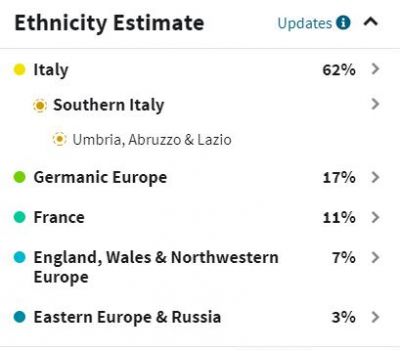This month was are taking a break from Italian civil records and are going to investigate DNA testing as I am guessing some of you may have received test kits as gifts last month.
Types of DNA Tests
There are three main types of kits sold for consumer DNA testing: Autosomal, Y-DNA and mtDNA. The most common is autosomal which is the type of test that are in the kits sold by Ancestry, 23 & Me, FamilyTree Family Finder, and My Heritage. Because you inherit equal amounts of DNA from your parents, the Autosomal DNA tests allow you to explore both sides of your family tree. The Y-DNA test examines a man’s paternal line and would only contain information about the direct male ancestors in his lineage. This test is useful if you want to determine if a group of men with the same surname are related. The mtDNA is the Mitochondria DNA test. This test follows one’s maternal line. Women pass down their mtDNA to both their sons and daughters, but only daughters can pass it on to their children. This test is useful if you are trying to narrow down a female ancestor’s line or surname.
What can you learn?
Looking at just the Autosomal tests, your test results will show an estimate of your ethnicity and a list of others who have taken the same test with whom you share ancestral DNA. Each testing company has different formulas for how they calculate ethnicity and for how they determine how closely you are related to your DNA matches. Sometimes when you see your ethnicity estimates you might be surprised by the results. Keep in mind that DNA reaches back a few hundred years and you have little bits of DNA in you from some of your ancestors who lived over 200 or more years ago. I use the word some to emphasize that you do not inherit DNA from all of your distant ancestors. DNA is lost over generations because you only inherit half from each parent and each of your parents only inherited half from each of their parents and so on.
As for the accuracy of the ethnicity estimates, the testing companies use proprietary formulas and are constantly refining their calculations based on the increasing number of people who test their DNA. As more people test, the estimates evolve and become more accurate. Most of us think of our ethnicity based on current geopolitical boundaries, but when our ancestors were born that country may not have even existed. For some ethnicities, you may find the results to be very narrow pointing to a certain region of Italy or to a region that encompasses more than one country. For example, I have French DNA that comes from my mother who we believed to be mostly German and a little bit Croatian. However, my research into her family tree on paper only goes back to the late 1700s, so it is very possible that she had ancestors born in the early-mid 1700s who were of French origin and emigrated to Germany or Croatia. The main point is to keep an open-mind when you receive your results and take some time to learn the history of migration and conflict in the part of the world that your family once lived in.
Privacy and Secrets
Before you send off your DNA to a testing company there are some things you need to be aware of when it comes to privacy and secrets. Some of the companies will use your anonymized DNA data (personal details are removed) for medical research or sell it to a third party for their research. It’s important that you read the privacy and consent information provided by the company. I decided that the benefits of the information I received and the opportunities to connect with others who share ancestral DNA was worth the privacy tradeoff, but it is a personal decision.
I recommend this online article for an in-depth discussion https://dna-explained.com/2015/12/30/23andme-ancestry-and-selling-your-dna-information/.
DNA results can sometimes uncover long buried family secrets. Individuals who have taken DNA tests may find that a parent who raised them is not their biological parent or they are contacted by adoptees who have taken the test in order to find a birth parent. If you test and decide to share your results, you need to be prepared that DNA may uncover things about you or your family that could be unpleasant. I have connected with several adoptees and a few individuals whose DNA results brought a surprise. While most were positive experiences, a few were quite upsetting for the individuals involved. Everyone’s experience with DNA testing will be just as unique as each one of us. It is important that before you send in your sample, you know what to expect and are prepared for the results. Overall, I have been immensely pleased with the results from my testing and it has enabled me to take my research into new directions and I have met a lot of wonderful cugini from all over the world.



